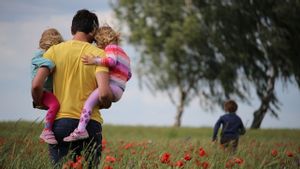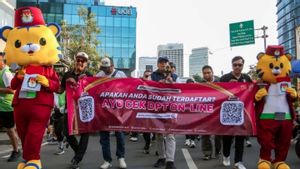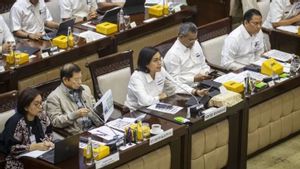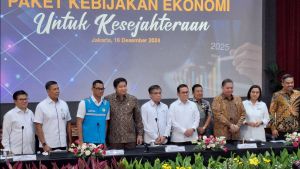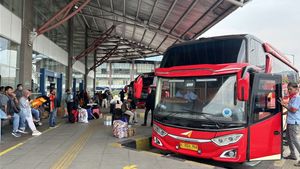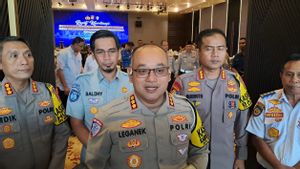JAKARTA Later, fish milk became a hot topic of conversation as proposed as an alternative to cow's milk in a free nutritious eating program in Indonesian schools. Not only more economical, fish milk is also considered more environmentally friendly than cow milk.
The proposal to include fish milk in the free nutritious food program owned by the President and Vice President Elect Prabowo Subianto-Gibran Rakabuming Raka was conveyed by the President Director of Food Holding ID Food, Sis Apik Wijayanto in a working meeting with the DPR RI.
According to Sis Apik, the procurement of milk from integrated dairy farming takes two to three years. For this reason, ID Food examines alternative milk other than cow's milk for the fulfillment of the free Prabowo-Gibran milk program.
"Procurement of milk from the mega farm takes two to three years, what is proposed is that the initial procurement is maximized to local breeders throughout Indonesia, but if there is no alternative product that can be done as a substitute for cow's milk, for example there are fish," said Sis Apik at the DPR RI Building.
"This is still under study. This proposal has been submitted by several community leaders, but the aroma of fish milk still needs improvement," he added.
An elementary school kid in Indramayu Regency who was drinking fish milk during last year's fish milk launch event. ANTARA/ (HO-KKP)
For information, fish milk was launched by the Ministry of Marine Affairs and Fisheries (KKP) together with the Ministry of Cooperatives and SMEs (Kemenkop UKM) in Indramayu in 2023 as an effort to increase downstream fishery products.
The innovative product fostered by KKP MSMEs is made from fish which is then processed with modern technology to produce Fish Protein Hydrolicity (HPI) as a raw material for fish milk.
"This will be an important factor in increasing downstream fisheries, in line with President Joko Widodo's direction," said Minister of Maritime Affairs and Fisheries Sakti Wahyu Trenggono in his official statement.
This product, he continued, is an innovation product that combines the benefits of fish proteins for health with diversification of processed products so that they can increase added value and product competitiveness, in line with the KKP priority program.
During the discourse on using fish milk to fulfill the free nutritious eating program in the Prabowo Subianto government, most of them did not accept this idea. The reason is because the local public believes that dairy products always come from breastfeeding animals such as cow milk or goat milk.
Talking about fish milk, actually this product is not the same as milk products that have been known to the wider community. Although called fish milk, this product does not actually come from milk glands such as cow's milk or goat's milk, but from extrasion of fish protein, usually sea fish rich in omega-3.
Fish milk is a food diversification product, especially in the fisheries sector. Fish is processed through modern technology so that it can produce Fish Protein Hydrolytes (HPI). Later it will become a raw material for fish milk. This HPI is further processed so that it produces high-protein beverage products. So, it is actually more appropriate to be called protein drinks with fish basic ingredients.
Fish milk is developed as an alternative to land animal-based milk, with the aim of providing a high source of nutrients, especially protein, without having to rely on cow's milk or other dairy products. Fish milk is made in liquid form that can be drunk directly or used as raw material in the manufacture of other food products. It tastes more neutral and doesn't smell as beggar as people imagine.
Chairman of the Advocacy Committee for the Acceleration of Stunting Sequence, Maternal and Child Health and SDG's Executive Board of the Indonesian Doctors Association (PB IDI) Agussalim Bukhari explained how the process of making fish milk. He said, fish milk is made from hydrated protein.
"The production of this type of milk that he comes from processing, yes, the scientific term is hydrolysic fish protein, which is a chemically hydroly analyzed fish protein so that it contains concentrat, which is smaller," said Agussalim in a media discussion held online.
He said that both cow's milk and fish milk have good protein content, but there is an advantage for fish that does not have much in cow's milk, namely omega-3 which is good for brain growth and heart health. Fish milk, continued Agussalim, is also low in lactose so it is safe for children who are intolerant of lactose in cow's milk or often called cow's milk allergy.
"One advantage, if everyone knows that it contains omega 3, it's an advantage for fish, especially for milk, omega 3 is also good for cancer, good for the heart, brain development and of course anti-inflammatory," he explained.
Agussalim said that the large number of Indonesian children who do not like fresh fish, makes fish milk a good alternative. He explained that the process of making fish extract into cow's milk can reduce the nutrition of the fish by up to 50 percent because the heating process is processed into milk. Therefore, even though fish milk contains protein, vitamins, and minerals, it is not enough from just one source, vegetable and fruit consumption must still be added to meet it.
Meanwhile, if there are still many fish in the place of residence, it is better to eat fresh fish meat because the protein, vitamins and minerals are still intact. Fish milk can be used as an alternative for those who find it difficult to access fish meat and other options for relatively more expensive cow milk.
Ahead of the start of the Prabowo administration in October, the availability of cow's milk is in the spotlight because this is said to be included in products prepared in the free nutritious eating program.
However, Indonesia has not been able to meet the needs of domestic cow's milk independently. In the report of the Indonesian Chamber of Commerce and Industry (Kadin) with the title "The Single narration of Dairy Cows" in March 2024, national fresh milk production was still minimal, even far below its consumption level during the 2017-2020 period.
In 2017, Indonesia only produced 918.24 thousand tons of fresh milk, while the total consumption or demand reached 4.27 million tons. To cover the shortage of supplies, the government imported around 3.36 million tons of fresh milk.
This means that during the 2017-2020 period, Indonesia's fresh milk production only met around 21-22 percent of the national consumption needs, while 77-78 percent of the national milk demand was met through imports.
SEE ALSO:
Fish milk is said to be an alternative while the government prepares a jumbo farm (mega farm) for dairy cows, because it takes three to four years to prepare a mega farm to operate and produce milk to fulfill in Prabowo's ambitious program.
Institute for Democracy and Credit Studies (IDEAS) researcher, Nuri Ikawati, said that overall the use of fish milk could be an alternative to be used on a large scale for national programs. However, he also reminded that it cannot be realized in the near future because it must consider many things.
"Maybe it can be done, but it will take time, investment in technology and research, as well as infrastructure support," said Nuri.
The success or failure of this fish milk program will also depend heavily on public revenue and the ability of the fisheries sector and the food industry to meet large-scale needs on a sustainable basis.
The English, Chinese, Japanese, Arabic, and French versions are automatically generated by the AI. So there may still be inaccuracies in translating, please always see Indonesian as our main language. (system supported by DigitalSiber.id)



